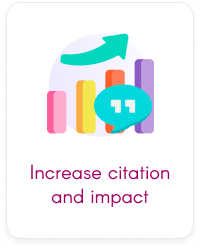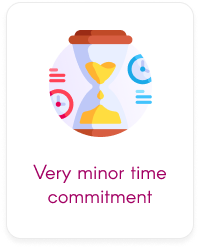Create your Video
Let the world see your research
Why communicate with video?
Video and animation can quickly bridge geographic, demographic, and language barriers, allowing you to communicate and quickly share the message of your research to a time-conscious society.
Don’t sit and wait for print and online media to find you. Make sure you have information ready for your website, blog, and social media channels so that people can quickly learn about your research and find out why it’s interesting.
What we do
Our team is unique. We are a group of academics, publishers, marketers, designers, and media specialists who have come together from around the world to help you achieve maximum impact from your research.
You deserve it.






What we offer
Video
A two-minute video summarising your research. Using a mixture of still images, video clips, background music, and subtitles.
Animation
A three-minute 2D animation summarising your research. Created with 2D animated graphics, background music, and voice narration.
Editorial Process





Choose your product and order
Video
£1400 GBP
(*we can invoice in any currency)
Animation
£2200 GBP
(*we can invoice in any currency)
Feel free to contact us for further information, or visit our frequently asked questions page
Q: What is SciPod?
Cognitive differences mean that some people absorb knowledge by listening, and others visually. We have developed two strategic multi-media communication tools, AudioPod and VideoPod, to help you to reach and influence the widest possible audience.
AudioPod: We will transform your scholarly paper into a layman 10-minute audio summary.
VideoPod: We will transform your research into an eye-catching, informative video summary.
Q: Why do I need a SciPod?
A large number of researchers are actively encouraged by their institute or funding agency to showcase their work beyond their own niche communities and traditional publishing channels, especially when it comes to taxpayer-funded research. Engaging with the public is of increasing strategic importance for higher education, to build trust and strengthen relevance, responsiveness and accountability.
Each SciPod is produced and published by our industry leading team. Our team of editors, science writers, voice actors, designers and media specialists is unique in the industry and is perfectly placed to help you achieve a far-reaching impact for your research.
We are here to work with you, and to help your research reach the large audience it deserves.
Q: Why is outreach and public engagement important?
Moreover, given the significant change in the way information is disseminated and accessed, people want more from researchers, academic institutions, and industry than ever before. As a result, the topic of science communication is a growing area of interest.
It is now widely accepted that broader science communication (outreach and public engagement) is a fundamental aspect of a scientist’s career. While many do recognise this, it can be a challenge to do it effectively. Despite the benefits of broader science communication, scientists report barriers to engaging public audiences, including busy schedules and concerns that it will take time away from their research.
SciPod helps overcome these barriers, by offering a professional communication and dissemination service to support and enhance research. We make research understandable, enjoyable, accessible, and open.
Q: Why an audiobook or animation? I’m encouraged to publish in text by my peers.
A major motivation behind SciPod was the desire to create an inclusive platform that offers ALL people an opportunity to learn. With an estimated 700 million dyslexic people, and 285 million visually impaired people, SciPod provides learning opportunities for communities that are often overlooked in scholarly publishing.
We have no intention of trying to replace text communication. We are aiming to compliment and support it.
Q: So an AudioPod is an audiobook, what’s the difference between an audiobook and podcast?
Audiobooks are a very specific singular narration of pre-existing text.
They somewhat overlap, but both serve as a great communication tool. However the production efforts and delivery differ. A simple comparison would be listening to a radio show (podcast) vs listening to a book on Audible (audiobook).
Audiobooks are timely, and complex to create, this is why we only offer this as a paid service. Podcasts are much easier to create and can be done with the phone in your pocket. Check out our academy page for advice on how to create your own podcast.
Q: VideoPods are available in two formats, Research Byte and Research Animation. What's the difference?
We wanted to create two video services to help researchers with varying budgets have the opportunity for their research to be available on YouTube and try and compete with prime time TV.
Research Byte: A simplistic two-minute video created using a series of still images and video clips. Completed with background music and subtitles.
Research Animation: A more bespoke three-minute video created with full 2D animation. These videos are more customisable and all graphics created are unique to your research.
Q: Ok, so how does SciPod work?
Each SciPod is produced and published by our industry leading team. Our team of editors, science writers, voice actors, designers and media specialists is unique in the industry and is perfectly placed to help you achieve a far-reaching impact for your research
Each SciPod is based on a single research paper, and our team works to present the research in the most accessible, understandable and enjoyable way. Audiences with varying levels of expertise and knowledge will be able to understand the significance and potential impact of the research.
Q: What is your simple 4-step production process?
Step 2 – SciPod script produced
Our writing and editing team will produce the first plain language summary script within 10 days. Our standard-length script is approximately 1100 words for AudioPod and 500 words for VideoPod. Once produced, this is sent back to you for review and approval. We do not publish anything without your 100% approval.
Step 3 (AudioPod) – We go to the recording studio
The script is passed to our professional voice artists who elegantly and clearly read your script and produce the first audio draft. The draft is then sent to you to listen and approve before the final stages of completion.
Step 3 (VideoPod) – We go to the recording studio
We then produce a storyboard to help you visualise and comment on the potential animation. Once you have approved the storyboard, we produce a full-colour 3-minute 2D animation
Step 4 – Your SciPod is published
We produce a unique webpage within our digital library for you. We then disseminate to our direct audience and through our audio social media channels on Twitter, Facebook, YouTube, TikTok, Audible, Soundcloud, iTunes and Spotify, to name a few.
It’s as simple as that. On average the process should take no longer than 1 hour of your time over a period of 2–4 weeks for AudioPod, and 4-8 weeks for VideoPod. Quicker production times may be available on request.
Q: Will I get a chance to review and approve before publishing?
Q: Where will you publish my SciPod?
Our dissemination team promotes each SciPod through our website, social media channels, and news aggregators.
You will receive the ownership of your SciPod so that you have unrestricted re-use. We want you to show your SciPod off, the more it is used, the more visible your research becomes.
Q: Where will you disseminate and promote my SciPod?
This does not take into account pass-on audience metrics, which is responsible for an additional 75% of listeners and viewers worldwide (i.e., a high school teacher downloads a SciPod and then plays it to their classroom of students).
Our VideoPods are additionally disseminated through YouTube, TikTok, Instagram Videos, Facebook, Twitter, Flipboard, Google News, and LinkedIn.
Our AudioPods are additionally disseminated through Audible, Apple iTunes, Spotify, Google Podcasts, Amazon Music, SoundCloud, Researcher App, Stitcher, Breaker, Pocket Cast, Radio Public, Twitter, Facebook, LinkedIn, Overcast, Castbox, Podimo, and Podtoppen.
Q: Can I or my institute use the SciPod for our own communication efforts?
For example, post it directly on your University’s website or newsletter, add a link to it in your CV as a summary of your recent work, add it to your conference poster with a QR link, or shout about it on social media – the choice is yours.
Q: What licence covers my SciPod?
Q: What type of research topic do you accept?
Try us, we will work closely with you until you are completely satisfied with your SciPod before it is published.
Q: Can I choose the focus of the SciPod?
In other words, we write our SciPod articles using research articles or reviews that have already been published in reputable peer-reviewed journals to help control the quality of the research we cover.
Q: I have published a preprint, and want to produce a SciPod to support my paper submission, is this ok?
Q: My paper is currently in review, can i work with you before it is accepted?
Q: Will there be any copyright issues with the original publisher?
Q How will SciPod affect impact?
Consider outreach and general communication as an impact metric in itself. If your government plan to cut your research funding and there is no public reaction. Or there is generally low interest being taken in your studies from policy makers and stakeholders. Then your current approach to communication is not working and you need to try something different.
As for more traditional scholarly impact. According to Wiley, one of the leading scholarly publishers, having a video to support your scholarly paper creates 111% higher full text views of the original paper. SciPod has also shown to significantly improve the Altmetric scores and visibility of the original scholarly paper we cover. For example, this SciPod helped to raise the Altmetric score of the original science paper from 8 to 25 within 3 weeks of the SciPod’s release: https://mdpi.altmetric.com/details/53936492
Q: This all sounds good, but what is the cost?
We have worked very hard to bring our communication services to the research community at a very reasonable price. These prices are the total tax-free cost that covers the full production, distribution and digital hosting. The fee also allows us to pass the copyright of the material back to you, so that you may use it freely and independently.
Our AudiPod cost start from £550 GBP (approximately $670 USD, €640 EUR).
Our VideoPod cost start from £1400 GBP (approximately $1700 USD, €1600 EUR).
Bulk orders are also available on request.
Q: Is this an eligible expense for my grant?
Q: Is this an allowable expense for academic publishing?
Q: What payments do you accept?
Our invoices have a 45-day payment term which has been set to allow plenty of time for the first draft of the article to be produced by us, and approved by you. Our intention here is making sure that we are not asking for the payment in advance of any works being produced, as is familiar in scholarly publishing. However, where we do differ from scholarly publishing is the fact that we incur editorial and production costs from the get-go. So, the 45-day term is there to be fair to our authors and institutes, and also to be fair to our initial financial commitment in taking each project on.

